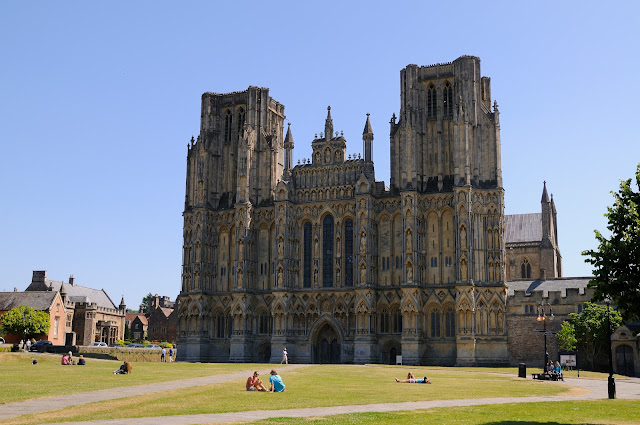The Yorkshire Moors have always been popular places to visit as they are beautiful and full of history. There are many novels also written about them which give them a dark and foreboding character - places of mystery! We found a beautiful place to stay in Pickhill, (which was far from `dark and foreboding`) near Thirsk, Yorkshire. The bungalow was on a farm, and was like home from home - Amazing!
One of the first places that we visited was through Thirsk, and was called Sutton Bank.
Sutton Bank is a hill in the Hambleton District of the North York Moors National Park, North Yorkshire in England. It is a high point on the Hambleton Hills with extensive views over the Vale of York and the Vale of Mowbray.
At the foot of Sutton Bank lies the village of Sutton-under-Whitestonecliffe; at 27 letters long, it has the longest hyphenated place name in England - how about that!
The A170 road runs down the bank with a maximum gradient of 1 in 4 (25%), and including a hairpin bend. Vehicles have to keep in low gear whilst travelling up or down the bank, and caravans are banned from using the section. Luckily the weather was good the few time we drove it during the week, which made life a bit easier.
Because it faces the prevailing westerly winds, Sutton Bank has been used by Yorkshire Gliding Club, based at the top of the hill, since the 1930`s I believe.
Ampleforth Abbey is a monastery of Benedictine Monks a mile to the east of Ampleforth, North Yorkshire, England, part of the English Benedictine Congregation, and also a College for 6, 7 & 8 year old children. It claims descent from the pre-Reformation community at Westminster Abbey through the last surviving monk from Westminster Sigebert Buckley (c. 1520 - c. 1610). Unfortunately, the Abbey has recently been embroiled in a sexual abuse scandal. (2017)
Monks are known for living peaceful lives with plenty of time dedicated to study and prayer.
But the Benedictine monks at Ampleforth Abbey have also found another way to fill their days - brewing beer. It is something they have not done for more than 200 years.
It appears to be a very successful venture!
The place is in magnificent surroundings which were highlighted by the autumn colours.
Byland Abbey was described in the 12th century as one of the shining lights of northern monasticism. Its beginnings were unpromising – it was only after 43 years and numerous moves that the community of Byland found a permanent home – yet the abbey rose to be one of the largest of the Cistercian order in Britain. The remains of the buildings, particularly the great church with its magnificent west front, are important in the development of northern monastic architecture in the second half of the 12th century.
Although there appear to be a large number of ruined abbeys spread around the countryside, their downfall may well have started in the reign of Henry VIII.
After Wolsey's downfall, Thomas Cromwell became Henry's chief minister and earned the confidence of the King by helping him to break with Rome and establish Henry VIII as head of the Church of England. This act also brought him much needed wealth through the dissolution of the well-funded monasteries. Over four years Cromwell ordered that 800 monasteries be disbanded and their lands and treasures taken for the crown.
I believe in fact, that the `church` had owned as much as a third of all the land in Europe!.
The cultural and social impact of this action was significant, as much of the land was sold to the gentry and churches and monasteries were gutted and destroyed. Henry's personal religious beliefs remained Catholic, despite the growing number of people at court and in the nation who had adopted Protestantism.
The church of St Michael's, Coxwold, sits at the western end of the village. The current church was built in 1420-30 and is an unusually elegant church for the area, with a most impressive octagonal tower.
The first documented reference to a church at Coxwold came in 757, when Pope Paul I ordered King Eadbert of Northumbria to repair it. This early Saxon church was replaced by a 11th century Norman church, which was in turn replaced by the current elegant building, built in the perpendicular style in 1420-30 and left largely untouched since.
Day two of our holiday we intend to make our way toward Gillamor, and then onto Lastingham.




















































